

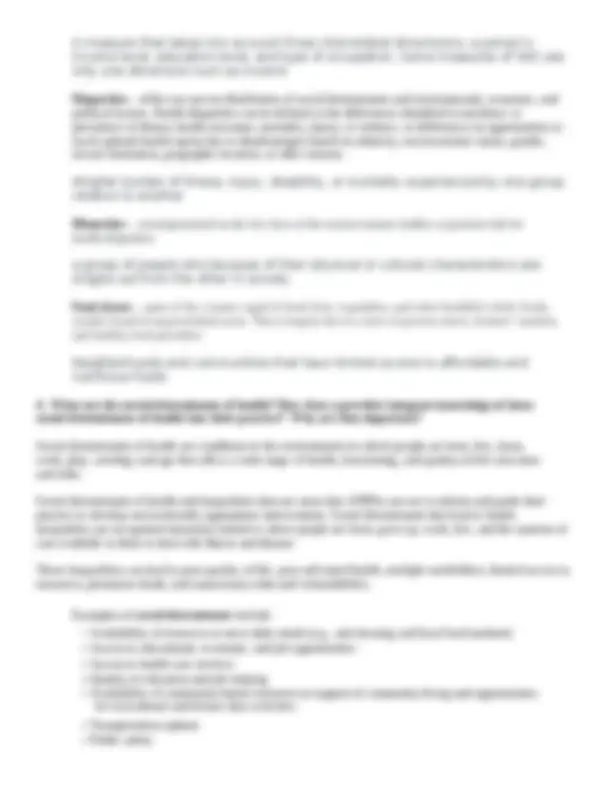
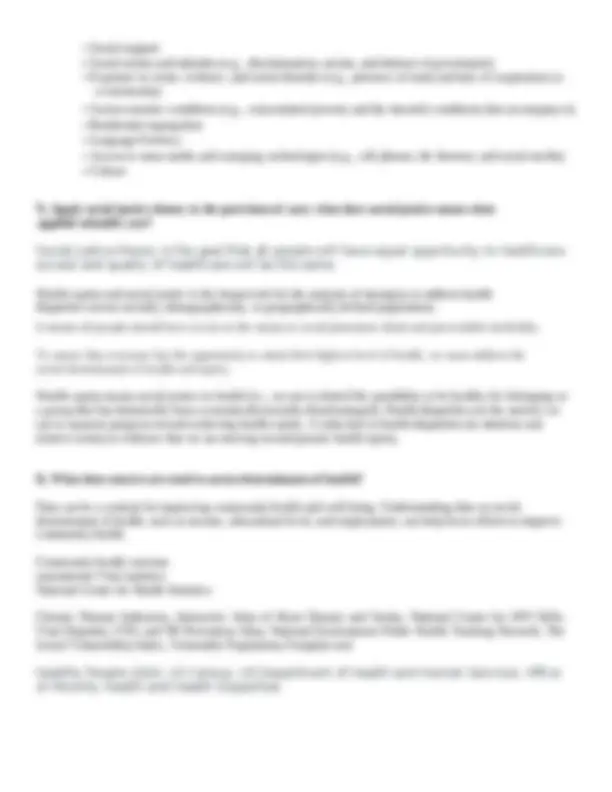
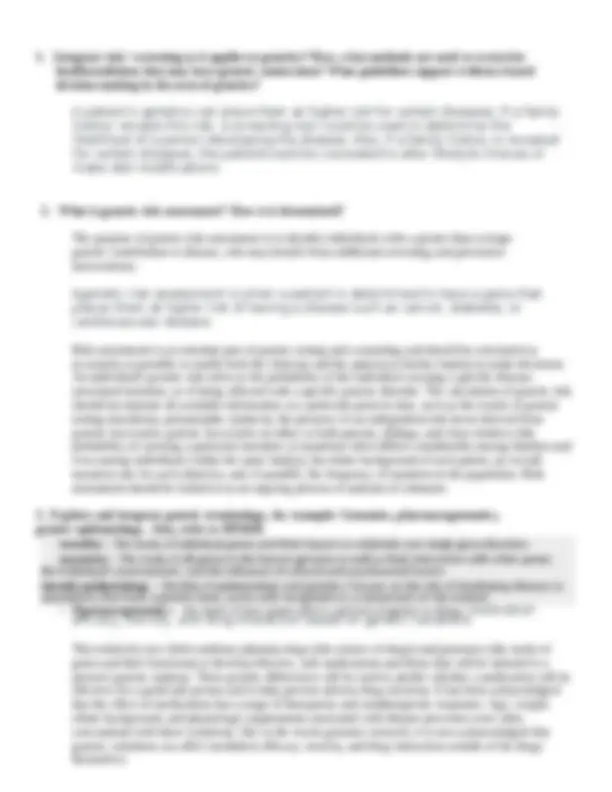
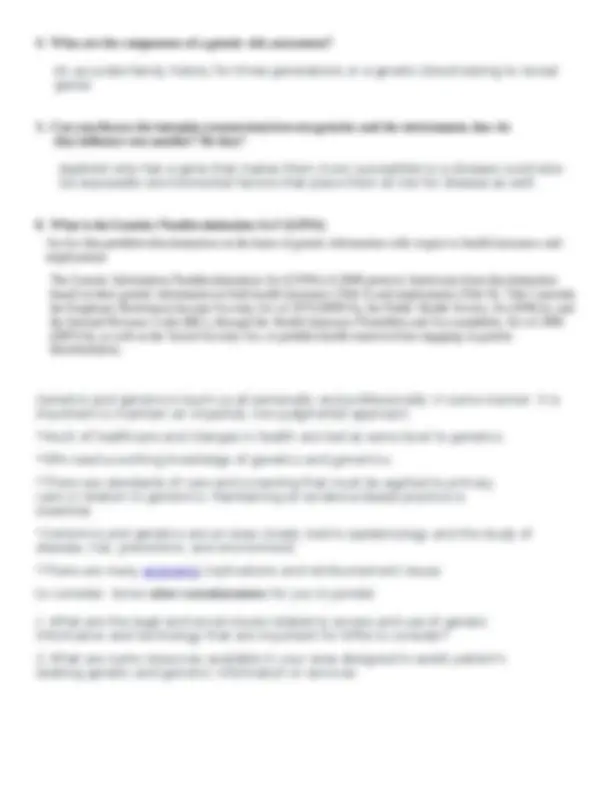
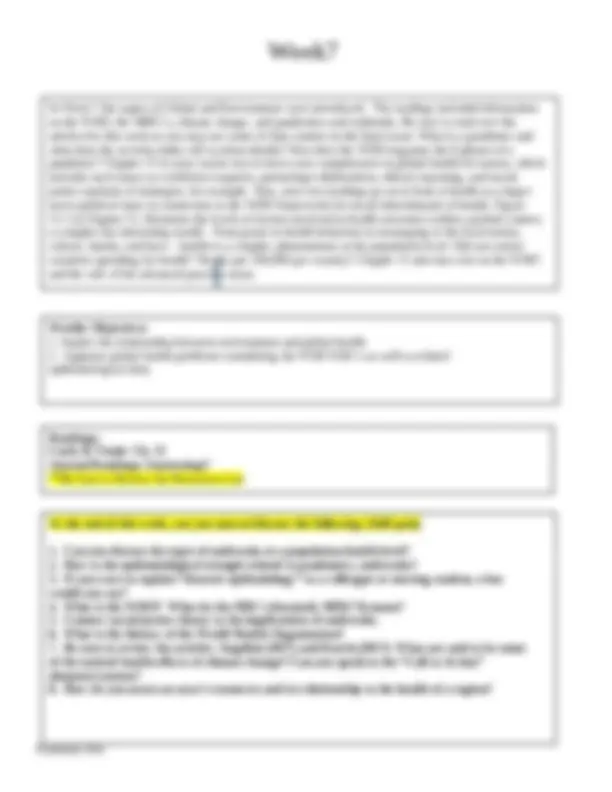


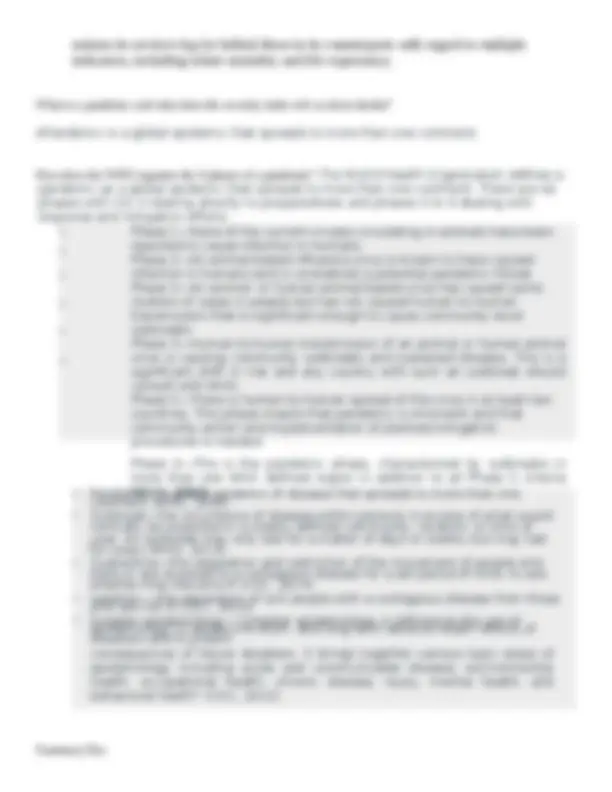




Study with the several resources on Docsity

Earn points by helping other students or get them with a premium plan


Prepare for your exams
Study with the several resources on Docsity

Earn points to download
Earn points by helping other students or get them with a premium plan
Community
Ask the community for help and clear up your study doubts
Discover the best universities in your country according to Docsity users
Free resources
Download our free guides on studying techniques, anxiety management strategies, and thesis advice from Docsity tutors
NR 503 Population Health, Epidemiology & Statistical Principles Final Exam Study Guide.(2022)
Typology: Exams
1 / 19

This page cannot be seen from the preview
Don't miss anything!












In Week 5 you completed your Infectious Disease paper. Are you able to define and apply the epidemiological triad and the HP2020 social determinants of health? How might you use those in your Week 6 paper? The determinants of health, from social to environmental from policy to individual behavior are critical elements to consider related to population health and the role of the NP. Also, in Week 5, the Open Forum gave you opportunity to review culture, access to care, and how provider attitudes impact quality of care provision. Did you take the self-assessment? Was it informative? Social justice theory is connected to the entire NR503 course, and also to this module, the Kleinman Explanatory Model. Had you heard of this before? Do you think the explanatory model would be useful in trying to understand various group’s notions of health? The 5W's of descriptive epidemiology: What = health issue of concern Who = person Where = place When = time Why/how = causes, risk factors, modes of transmission
Weekly Objectives:
heritage, Ibeliefs, Iattitudes, Iand Ibehavior Iof Ithose Ito Iwhom Ithey Irender Icare. care Iagency Ifind Imeaningful Iand Iuseful Icare Idelivery Istrategies Ibased Ion Iknowledge Iof Ithe Icultural a Idynamic, Ifluid, Icontinuous Iprocess Iwhereby Ian Iindividual, Isystem Ior Ihealth Discriminate populations at risk for development of chronic health conditions while associating the role of the Advanced Practice Nurse inlevels of promotion. Minorities and people with low socio-economic conditions are at higher risk for chronic illness. The APN should practice with cultural competence in order to provide care for these patients. Asking questions and researching to know how each patient perceives their illness and how they would like to treat it. Compare and contrast variables that differentiate those categorized at being at risk for marginalization of health care. Variable that differentiate those categorized as high-risk health literacy, cultural barriers, andlow English proficiency
1. How does culture influence the decisions a provider may make when selecting an intervention? The very essence of what health and disease denotes can vary from culture to culture. Therefore, there is a wide spectrum of what are considered appropriate interventions, which may not be compatible with Western medicine. Based on the cultures' perceptions of disease causation, symptomatology, and pathology, appropriate interventions may diverge from Western medicine's approach. In order to provide appropriate healthcare interventions, culture and all its variants must be addressed (communication, space, time, environment, etc). The APN must be cognizant of his or her own cultural beliefs and the attitudes he/she inherently has about other cultures. Patients culture must be addressed when providing care for patients. Good communication between provider and patient bridges the gap and provides culturally competent care. 2. Explain how culture impacts provider attitudes? Does it? How will you assess your own attitudesIabout various cultures/races/groups? Differences in culture can impact provider attitudes. Although cultures differ, they all have the same basic organizing factors that must be assessed in order to provide care for culturally diverse patients. These factors include: communication (verbal and nonverbal); personal space; social organization; time perception; environmental control; and biological variations. Cultural competency training and cultural awareness can help APNs assess his/her own attitudes. 3. Review the terms for this week and apply them to population health; for instance: cultural competence, cultural awareness, norms, values, Kleinman Explanatory Model, socioeconomic status, disparities, minorities, food dessert. Culture – "the practices, beliefs, values, and norms which can be learned or shared, and which guide the actions and decisions of each person in the group" Cultural competence – I I I
A measure that takes into account three interrelated dimensions: a person’s income level, education level, and type of occupation. Some measures of SES use only one dimension such as income Disparities – reflect an uneven distribution of social determinants and environmental, economic, and political factors. Health disparities can be defined as the differences identified in incidence or prevalence of illness, health outcomes, mortality, injury, or violence, or differences in opportunities to reach optimal health equity due to disadvantages based on ethnicity, socioeconomic status, gender, sexual orientation, geographic location, or other reasons. Ahigher burden of illness, injury, disability, or mortality experienced by one group relative to another Minorities – overrepresented on the low tiers of the socioeconomic ladder; at greatest risk for health disparities a group of people who because of their physical or cultural characteristics are singles out from the other in society Food desert – parts of the country vapid of fresh fruit, vegetables, and other healthful whole foods, usually found in impoverished areas. This is largely due to a lack of grocery stores, farmers’ markets, and healthy food providers. Neighborhoods and communities that have limited access to affordable and nutritious foods
4. What are the social determinants of health? How does a provider integrate knowledge of these social determinants of health into their practice? Why are they important? Social determinants of health are conditions in the environments in which people are born, live, learn, work, play, worship, and age that affect a wide range of health, functioning, and quality-of-life outcomes and risks. Social determinants of health and inequalities data are areas that APRNs can use to inform and guide their practice to develop socioculturally appropriate interventions. Social determinants that lead to health inequalities are recognized situations related to where people are born, grow up, work, live, and the systems of care available to them to deal with illness and disease. These inequalities can lead to poor quality of life, poor self-rated health, multiple morbidities, limited access to resources, premature death, and unnecessary risks and vulnerabilities. Examples of social determinants include: - Availability of resources to meet daily needs (e.g., safe housing and local food markets) - Access to educational, economic, and job opportunities - Access to health care services - Quality of education and job training - Availability of community-based resources in support of community living and opportunities for recreational and leisure-time activities - Transportation options - Public safety
Weekly Objectives:
In Week 6 you submitted your Evaluation of an Epidemiological Problem or Condition Paper. In this paper you analyzed a health problem using a population health focus while integrating epidemiological data and information. For instance, who are the at-risk sub-populations impacted by the chosen problem, the aggregate populations. Also in Week 6 genetics was the topic of the readings. New terms such as genomics and genetic epidemiology were introduced. The topic of screening and risk assessment using a genetics population health framework was discussed. The article by Belsky, Moffitt, and Caspi (2013) spoke about risk assessment, interventions and environmental causation. This article introduces us to genetic risk scores and family history as a way to assess genetic risks that may be present. The Week 6 Lesson links the Epidemiological Triad to genetics. The Triad is an important piece to review, did you read that genetics is considered an agent in the Triad? Remember to keep bringing the concepts from previous weeks forward as the course introduces new concepts.
1. Integrate risk / screening as it applies to genetics? How, what methods are used to screen for healthconditions that may have genetic connections? What guidelines support evidence-based decision making in the area of genetics? A patient’s genetics can place them at higher risk for certain diseases. If a family history reveals this risk, a screening tool could be used to determine the likelihood of a person developing the disease. Also, if a family history is revealed for certain diseases, the patientcould be counseled to alter lifestyle choices or make diet modifications 2. What is genetic risk assessment? How is it determined? The purpose of genetic risk assessment is to identify individuals with a greater than average genetic contribution to disease, who may benefit from additional screening and preventive interventions. Agenetic risk assessment is when a patient is determined to have a gene that places them at higher risk of having a disease such as cancer, diabetes, or cardiovascular disease. Risk assessment is an essential part of genetic testing and counseling and should be calculated as accurately as possible to enable both the clinician and the patient (or his/her family) to make decisions. An individual's genetic risk refers to the probability of the individual carrying a specific disease- associated mutation, or of being affected with a specific genetic disorder. The calculation of genetic risk should incorporate all available information at a particular point in time, such as the results of genetic testing (mutations, polymorphic markers); the presence of an independent risk factor derived from genetic test results; genetic test results on either or both parents, siblings, and close relatives (the probability of carrying a particular mutation or mutations often differs considerably among families and even among individuals within the same family); the ethnic background of each parent; an overall mutation rate for each ethnicity; and, if possible, the frequency of mutation in the population. Risk assessment should be looked at as an ongoing process of analysis of estimates. 3. Explore and integrate genetic terminology, for example: Genomics, pharmacogenomics, genetic epidemiology. Also, refer to HP2020. - Pharmacogenomics – the study of how genes affect a person's response to drugs; medication efficacy, toxicity, and drug interaction based on genetic variations This relatively new field combines pharmacology (the science of drugs) and genomics (the study of genes and their functions) to develop effective, safe medications and doses that will be tailored to a person's genetic makeup. These genetic differences will be used to predict whether a medication will be effective for a particular person and to help prevent adverse drug reactions. It has been acknowledged that the effect of medications has a range of therapeutic and nontherapeutic responses. Age, weight, ethnic background, and physiologic impairments associated with disease processes were often concomitant with these variations. Due to the recent genomic research, it is now acknowledged that genetic variations can affect mediation efficacy, toxicity, and drug interaction outside of the drugs themselves the individual’s environment, and the influence of cultural and psychosocial factors Genetic epidemiology – The link of epidemiology and genetics; focuses on the risk of developing disease, in populations that have a genetic basis, and is now recognized as a component of risk analysis. Genetics – The study of individual genes and their impact on relatively rare single gene disorders Genomics – The study of all genes in the human genome as well as their interaction with other genes,
Summary Doc In Week 7 the topics of Global and Environment were introduced. The readings included information on the WHO, the MDG’s, climate change, and pandemics and outbreaks. Be sure to read over the articles for this week as you may see some of that content on the final exam. What is a pandemic and what does the severity index tell us about deaths? How does the WHO organize the 6 phases of a pandemic? Chapter 11 in your course text reviews core competencies in global health for nurses, which includes such issues as workforce/capacity, partnering/collaboration, ethical reasoning, and social justice analysis of strategies, for example. Also, your text readings go on to look at health as a larger socio-political issue in connection to the WHO framework for social determinants of health. Figure 11.1 in Chapter 11, illustrates the levels of factors involved in health outcomes within a global context; a complex but interesting model. From genes to health behaviors to messaging to the local norms, culture, family, and laws – health is a complex phenomenon at the population level. Did you notice countries spending for health? Deaths per 100,000 per country? Chapter 11 also has a lot on the WHO and the role of the advanced practice nurse. Weekly Objectives:
Summary Doc
1. Can you discuss the types of outbreaks at a population health level? An outbreak at a population level is an epidemic. An outbreak or an epidemic exists when there are more cases of a particular disease than expected in a given area, or among a specific group of people, over a particular period of time. Another other term you might come across is endemic, meaning that a population has a high level of the disease all the time. 2. How is the epidemiological triangle related to pandemics, outbreaks? Host Factors, Environment factors, and Agent factors are more these days with the globaltravel. Knowing new strains develop and being able to contain the spread. If one part of the triangle is interrupted, it could disrupt the connection between the environment, the host, and the agent, and stopping the continuation of disease or the pandemic. 3. If you were to explain “disaster epidemiology” to a colleague or nursing student, what would you say? Iterm s 4. What is the WHO? What do the SDG’s (formerly MDG’S) mean? The WHO is the World Health Organization. Sustainable Development goals (SDGs) are 17 global development goals that were established in 2015 by the UN to reaffirm the commitment of individual nations for a collectiveIresponsibility for human dignity, equality, and equity. The Sustainable Development Goals are the blueprint to achieve a better and more sustainable future for all. They address the global challenges we face, including those related to poverty, inequality, climate, environmental degradation, prosperity, and peace and justice. The Goals interconnect and in order to leave no one behind. Building on the principle of “leaving no one behind”, the new Agenda emphasizes a holistic approach to achieving sustainable development for all. Disaster Iepidemiology Iis Idefined Ias Ithe Iuse Iof Iepidemiology Ito Iassess Ithe Ishort- Iand Ilong- Iadverse Ihealth Ieffects Iof Idisasters Iand Ito Ipredict Iconsequences Iof Ifuture Idisasters. IIt I brin g Itogether Ivarious Itopic Iareas Iof Iepidemiology Iincluding Iacute Iand Icommunicable Idisease,
Summary Doc
Summary Doc
Weekly Objectives:
Summary Doc
1. How do ethics and public policy intersect? Ethics are moral principles that guide behavior. Ethics contribute to public policies that are forthe good of the public. 2. What influence do you as a provider have regarding public policy? What ethical obligation do you believe you have? NPs have first-hand knowledge of the complexities of socioeconomic conditions associated with the health of vulnerable populations. Increased awareness of the social and economic determinants of health and health inequality affords NPs a unique opportunity to advocate for policy reform affecting vulnerable groups. As a provider and leader, NPs play a pivotal role in public policy. They have an increased awareness of the social and economic determinants of health and health inequality and havethe opportunity to advocate for policy reform affecting vulnerable populations. Policies could intervene to help foster and advance the role of NPs in serving vulnerable populations and conclude with the role of NPs in policy advocacy. 3. How is risk reduction, assessment, and outcomes related to public health policy? Risk reduction is an approach rooted in public health. It aims to improve the lives of people who are affected by whatever risks/diseases they have. Risk reduction, assessment, and outcomes are part of a cycle that contributes to the improvement of public health. If assessment and outcomes are not acceptable or to standard, then modifications are needed. 4. Where is the intersection of: epidemiology, population health, public policy and social justice and vulnerable populations? All elements are related to one another. Epidemiology deals with the incidence, distribution, and possible control of diseases and other factors relating to health. Population health is the health outcomes of a group of individuals, including the distribution of such outcomes within the group. Social justice theory is the goal that all people will have equal opportunity to healthcare access and quality of healthcare will be the same. Vulnerable populations include patients who are racial or ethnic minorities, children, elderly, socioeconomically disadvantaged, underinsured or those with certain medical conditions. Members of vulnerable populations often have health conditions that are exacerbated by unnecessarily inadequate healthcare. 5. Are you able to define the key ethical terms and apply them to population health? For instance, ethics, fairness and social justice.
Summary Doc The ethical principles that nurses must adhere to are the principles of justice, beneficence, nonmaleficence, accountability, fidelity, autonomy, and veracity. Social justice is fairness in everyone having an equal opportunity for health and wellbeing.